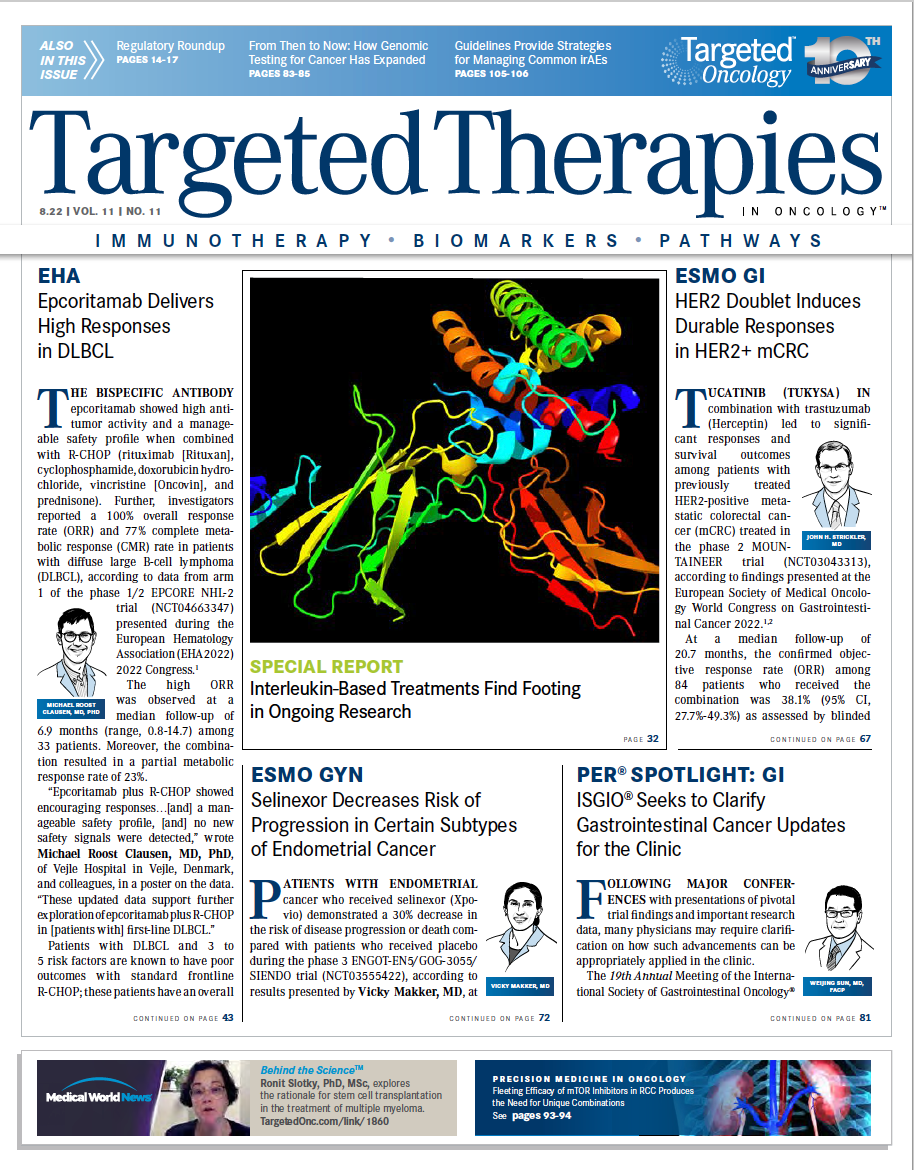Guidelines Provide Strategies for Managing Common irAEs
To assist clinicians in identifying, monitoring, and managing immune-related adverse effects, the American Society of Clinical Oncology issued guidelines in June 2022 updated by a multidisciplinary panel.

Immune-related adverse effects (irAEs) resulting from immune checkpoint inhibitor (ICI) therapy are distinct from other treatment-related AEs in terms of their timing, potential for long-term effects, and management. Although irAEs can occur shortly after treatment administration like treatment-related AEs, they can also occur at any point after the treatment administration, extending to 1 year or more beyond the end of treatment.
Presentations of IrAEs can reflect those of autoimmune diseases. Hence, the management of IrAEs often includes the use of immunosuppression with corticosteroids in the first line along with a temporary hold or permanent discontinuation of the ICI, depending on the grade of the AE. However, such IRAE treatments may result in additional toxicities, requiring monitoring and prophylaxis.1-4
To assist clinicians in identifying, monitoring, and managing IrAEs, the American Society of Clinical Oncology (ASCO) issued guidelines in June 2022 updated by a multidisciplinary panel.4,5
Guideline update lead author Bryan J. Schneider, MD, FASCO, clinical professor of medicine in the Division of Hematology/ Oncology at the University of Michigan in Ann Arbor, discussed the rationale behind the recent ASCO updates with Targeted Therapies in Oncology™. “We wanted to include more treatment options for steroid-refractory toxicity because this is often very difficult to manage, so adding more options for these toxicities was a main focus,” he said. “We also added additional immunosuppressive agents, mechanisms of action, and doses. I thought this was an important thing to include in the guideline because often these are being used by medical oncologists who may not be in a tertiary referral center with subspecialists on hand. So we tried to make the new guidelines a kind of one-stop shop [about] each mentioned drug and keep that all in 1 document.”
Schneider also pointed out that 2 new sections were added to the guidelines. “One was on the prevention and management of adverse events related to steroid use,” he said. “In oncology, outside of hematologic malignancies, we’re not accustomed to having people on high-dose steroids for long periods of time and a lot of adverse [events] can happen, so this is a good refresher about some pretesting and what symptoms to look for. Also, these updates serve as a good reminder on the importance of prophylaxis for [Pneumocystis jirovecii pneumonia (PCP)] and gastric ulcers because a lot of these patients may be [taking] steroids for several weeks.”
Cutaneous AEs
Although Schneider said there “weren’t any significant changes for the section of the guidelines addressing dermatologic [IrAEs],” they are the most common, reportedly affecting up to 71.5% of patients, with rash and inflammatory dermatitis leading the way.
Recommended management steps are tailored to the severity of the cutaneous event. Topical emollients or corticosteroids could be considered for a grade 1 event, whereas for grade 3 to 4 events, an ICI hold is recommended in addition to systemic steroid administration.
When autoimmune etiology is suspected or for grade 3 to 4 events, referral to a dermatologist is recommended.4-6
Gastrointestinal AEs
Reports of colitis in patients treated with an ICI range from 8% to 27%, and diarrhea affects more than half of patients treated with CTLA4 inhibitors, particularly in patients treated with both CTLA-4 and PD-1 inhibitors.4,5 “For colitis, we’ve got an earlier push to consider biologics like the TNF inhibitor infliximab [Remicade] or the integrin inhibitor vedolizumab [Entyvio] for steroid-refractory colitis,” Schneider said. “So instead of waiting a couple of weeks, if there’s not a dramatic clinical benefit to steroids, consider these biologics sooner rather than later. Also, if there are high-risk features on endoscopy such as deep ulcers, large ulcers, [or] multiple ulcers or [if] there is more colitis beyond the left colon, the patient needs more than corticosteroids. That was a big change in the guidelines.
“We also added that if the patient is unfortunately also refractory to those biologic agents to consider fecal transplant, the JAK inhibitor tofacitinib [Xeljanz], or the IL-12 antibody ustekinumab [Stelara]. Those are now third-line options that can at least help point the clinician in the right direction if they’ve got a horribly refractory case.”
Hepatic AEs
Patients treated with ipilimumab, nivolumab (Opdivo), and pembrolizumab (Keytruda) have a reported 2% to 10% incidence of hepatotoxicity.4,5 One particular diagnostic for patients with hepatotoxicity was a focus of the guideline update. “For hepatitis, there was more of a suggestion [in the guidelines update] to consider liver biopsy for the steroid-refractory patients and to rule out other potential etiologies like NASH [nonalcoholic steatohepatitis], tumor progression, other types of drug-related hepatic inflammation, infection, and other autoimmune processes,” Schneider said. “So I think it’s still reasonable to treat initially with steroids, but if they’re refractory to steroids, then biopsy should be strongly considered. I always like to add that mycophenolate mofetil [CellCept], which is the second-line therapy for hepatitis, works pretty slowly, so you may not see dramatic results for several weeks.”
Neurologic AEs
For patients receiving combination therapy, neurologic AEs including myasthenia gravis, aseptic meningitis, and peripheral neuropathy may affect from 3.8% to 12% of patients.4,5 The guideline update also included other potential neurologic toxicities. “For the CNS [central nervous system] toxicities, we addressed demyelinating diseases, including multiple sclerosis, transverse myelitis, and acute disseminated encephalomyelitis,” Schneider said. “They’re rare, but these are possible immune-related adverse events that can be seen with immune checkpoint therapy.”
Endocrine AEs
A reported 10% of patients treated with ICIs experience treatment-related endocrinopathies, which can present a complicated management challenge to nonendocrinologists.4,5 “For the endocrine section, we got more granular about the dosing of hormone replacement,” Schneider said. “We have included starting doses of hormone replacement for thyroid [IrAEs], especially for [older patients] or those with comorbidities who may need a lighter dose.”
Musculoskeletal AEs
The incidence of arthralgia and myalgia in patients treated with ICIs is reportedly as high as 40%, whereas inflammatory arthritis has been reported in 7% or less of this patient population.4,5 However, the guideline update focused on a particular musculoskeletal IRAE. “For the musculoskeletal IrAEs, the big [update] was really myocarditis,” Schneider said. “Myocarditis is one of the most life threatening of the toxicities. In some case reports, there is up to a 50% mortality with it. So there was the inclusion of abatacept [Orencia] or the CD52 inhibitor alemtuzumab [Campath] for steroid-refractory toxicity.”
Pulmonary AEs
The incidence of pneumonitis associated with PD-1 and PD-L1 inhibitors varies, but overall, 2.7% of patients are affected.4,5 Again, diagnostics were a guideline update consideration. “There wasn’t a huge change in the [guidelines with respect to] lung-related immune adverse events, but we commonly debate what type of imaging should be used if the patient is developing shortness of breath or cough and you’re worried about pneumonitis,” Schneider said. “It should be a CT with contrast because although we worry that they have pneumonitis, there could be a multitude of other things causing their cough or shortness of breath—PE [pulmonary embolism] being a big one—and you’re not going to see that with a noncontrasted CT. They say, ‘If you’re really looking for pneumonitis, you don’t need contrast,’ but obviously the differential is broad, so a contrasted CT is preferred.”
Monitoring Strategies and Supportive Care
“With respect to supportive care, you have to stay vigilant because these [adverse] effects can be subtle at first,” Schneider said. “So monitoring [is important], whether it’s for progressive weakness, or a new cough, or fatigue, which can be a sign of thyroiditis. It’s important to pay close attention because these things can be subtle and then accelerate. During visits, when I see these patients, I always ask each patient about rash, diarrhea, or new or worsening shortness of breath. Those seem to be the 3 toxicities that may get underreported. Also, immune-related thyroiditis that ultimately leads to hypothyroidism is something we see very frequently, so I always encourage, especially in the first 2 to 3 months of treatment, that TSH [thyroid-stimulating hormone] be checked at least every 3 to 4 weeks because that can change in a hurry.”
Grading IrAEs is also a guideline focus. “I always emphasize that the toxicity needs to be graded,” Schneider said. “We grade it 1 through 5, and we don’t do that formally with other [adverse] events outside clinical trials. But a lot of these toxicities will blindside you in clinic. Being able to grade the toxicity will very much help streamline the process of formulating a treatment plan. And the guidelines can help with that because the ASCO guidelines have the grades embedded in the work-up and management so that you can figure out how many stools a day they’re having equals what grade they are and therefore what the treatment plan would be. In broad strokes, if it’s grade 3 or 4 or a persistent grade 2, you should probably get the subspecialist to help out.”
Prophylaxis for patients treated with steroids long term is another guideline focus. “Don’t forget the [PCP] or GI [gastrointestinal] prophylaxis if the patient’s going to be on steroids for several weeks,” Schneider said. “The same thing applies to pneumocystis—some don’t believe that this is an issue, but I’ve seen at least 3 or 4 cases of Pneumocystis jirovecii in the hospital in people who were on long-term steroids who weren’t getting prophylaxis. So if I think they’re going to be on steroids for more than 3 to 4 weeks, I typically include [prophylaxis] too, and we’ve got that embedded in the guidelines.”
The current guidelines on managing irAEs include some “very important issues,” Schneider said. “It’s an important topic, and it seems like every time we turn around, there’s a new indication for these immune checkpoint inhibitors. With just the sheer volume of patients who are getting these drugs, we’re going to be seeing more and more of these adverse events, so I think these guidelines are critical to help these patients get treated early. “And the quicker you start management, the [easier] it is to turn around that adverse event.”
REFERENCES
1. Brahmer JR, Abu-Sbeih H, Ascierto PA, et al. Society for Immunotherapy of Cancer (SITC) clinical practice guideline on immune checkpoint inhibitor-related adverse events. J Immunother Cancer. 2021;9(6):e002435. doi:10.1136/jitc-2021-002435
2. Conroy M, Naidoo J. Immune-related adverse events and the balancing act of immunotherapy. Nat Commun. 2022;13(1):392. doi:10.1038/s41467-022-27960-2
3. Haanen JBAG, Carbonnel F, Robert C, et al; ESMO Guidelines Committee. Management of toxicities from immunotherapy: ESMO Clinical Practice Guidelines for diagnosis, treatment and follow-up. Ann Oncol. 2017;28(suppl 4):iv119-iv142. doi:10.1093/annonc/mdx225
4. Schneider BJ, Naidoo J, Santomasso BD, et al. Management of immune-related adverse events in patients treated with immune checkpoint inhibitor therapy: ASCO Guideline Update. J Clin Oncol. 2021;39(36):4073-4126. doi:10.1200/JCO.21.01440
5. Schneider BJ, Lacchetti C, Bollin K, et al. Management of the top 10 most common immune-related adverse events in patients treated with immune checkpoint inhibitor therapy. JCO Oncol Pract. 2022;18(6):431-444. doi:10.1200/OP.21.00776
6. Olsen TA, Zhuang TZ, Caulfield S, et al. Advances in knowledge and management of immune-related adverse events in cancer immunotherapy. Front Endocrinol (Lausanne). 2022;22;13:779915. doi:10.3389/fendo.2022.779915

Bispecific Antibodies and ADCs Deliver a Futuristic Horizon Across Lung Cancer Settings
October 23rd 2024Recent advancements in protein engineering, especially antibody-drug conjugates, show promise in lung cancer treatment, with ivonescimab outperforming pembrolizumab in PD-L1-positive advanced non-small cell lung cancer.
Read More